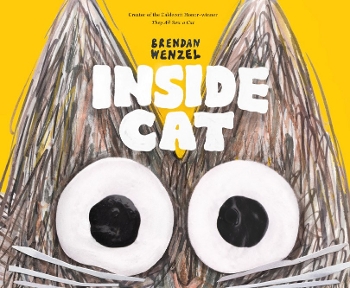There’s really quite a lot happening within each full-bleed spread in Brendan Wenzel's Inside Cat. Its triumph to me (and maybe the committee, too!) is the sheer dedication to and continuity of the theme, as outlined by the award criteria.
 Cats, both inside and outside, are admittedly unfamiliar territory to me, a dog person as required by my allergies. Brendan Wenzel’s They All Saw a Cat (a 2017 Caldecott Honoree) and now Inside Cat have so kindly offered an outlet through which to admire them from a safe distance. His care and cleverness in illustrating the feline form has delighted both my students and me, and Inside Cat proves to be no exception.
Cats, both inside and outside, are admittedly unfamiliar territory to me, a dog person as required by my allergies. Brendan Wenzel’s They All Saw a Cat (a 2017 Caldecott Honoree) and now Inside Cat have so kindly offered an outlet through which to admire them from a safe distance. His care and cleverness in illustrating the feline form has delighted both my students and me, and Inside Cat proves to be no exception.
We encounter the curiosity of this cat from the outset: “Inside Cat knows many windows, / finds a view wherever it goes.” At first, the windows themselves serve as a source of intrigue for the cat and the readers following along: their size, shape, orientation, and even their state of repair keep the cat climbing, story to story. Wenzel works in a window of every kind in this nontraditional home, and its most curious resident manages to find every single one through the course of this picture book.
Beyond those framed panes of glass, though, are the views themselves. Inside Cat “knows what’s hiding in the gaps.” In the final sequence of pages, the reader sees the cat’s perception of what’s happening beyond the scope of the pane of glass. A train car speeds by on spindly legs, and parade floats appear as “WILD BEASTS!” Wenzel deftly plays with the liminal space where a window ends and the cat’s imagination of the exterior world begins — that is, until the final breathtaking spread: “Oh,” indeed!
There’s really quite a lot happening within each full-bleed spread in this book. Full-color slices of the outside world dot the pages with cityscapes and passing creatures. Filling the rest of the space is the (equally fascinating) interior of Inside Cat’s home. These two spaces could clash if handled less carefully, but inside is conveyed by a white background and watery, pastel outlines, nearly like a blueprint for the home, as described by Wenzel in an interview with John Schu. In doing so, Wenzel centers focus on what’s happening outside these windows while leaving space for visual exploration of the interior, too. (If you’ve read this book with children, you’ve inevitably tracked the mousey shenanigans happening across these white spaces.)
When it comes to the cat itself, Wenzel makes a lot from very little. The cat’s eyes, two googly-eyed circles, carry the weight of the cat’s focus, emotion, and personality. Its body, formed entirely from brown shades of textured, energetic lines, moves the reader's eyes from the verso to the recto on each double-page spread as it stops at each window — a masterful strategy to carry the eye and entice that next page-turn.
Inside Cat’s triumph to me (and maybe the committee, too!) is the sheer dedication to and continuity of the theme, as outlined by the award criteria. Opened wide, the wraparound jacket features the titular Inside Cat peering intently out at the reader with those same googly-eyes and its body and tail visible to its left side (the back of the jacket). Slipping off the jacket reveals on the case cover the cat-shaped exterior of the feline’s home, an exact match to the furry cat that readers just pulled away. The front endpapers reveal the interior of the same structure, seen through a sort of x-ray vision. Just when you think the cat-within-a-cat couldn’t stretch further, the final endpapers offer an aerial view of Inside Cat’s home on an archipelago shaped like — you guessed it — a cat.
Reading this book with my students affirmed how successfully Inside Cat caters to a child’s sensibilities. Sure, there’s the delight of finding those mischievous mice hiding in the tortilla chip bowl, but there’s also the joy of knowing just a little more about the world than the cat does. That squirrel is no “fluffy rat,” and those “roaring flies” are helicopters, of course! Wenzel’s playful exploration of perspective situates children to both take pride in their own knowledge and to be challenged to understand how something may look a little different when you can’t see the whole picture, whether through a pane of glass or not.
There’s plenty to argue Inside Cat’s case for Caldecott recognition: skill in the medium used, attention to a child audience’s sense of curiosity and humor, and clever delineation of theme. Sadly, though, there are no windows into that discussion room, so we’ll wait to see the committee’s perspective, come January!
[Read the Horn Book Magazine review of Inside Cat.]
ALREADY A SUBSCRIBER? LOG IN
We are currently offering this content for free. Sign up now to activate your personal profile, where you can save articles for future viewing.








Add Comment :-
Be the first reader to comment.
Comment Policy:
Comment should not be empty !!!